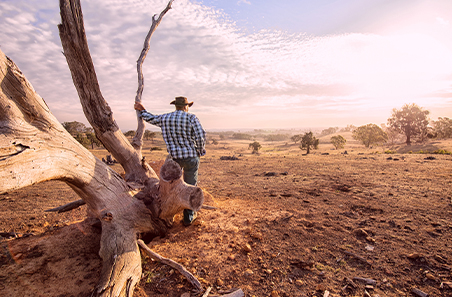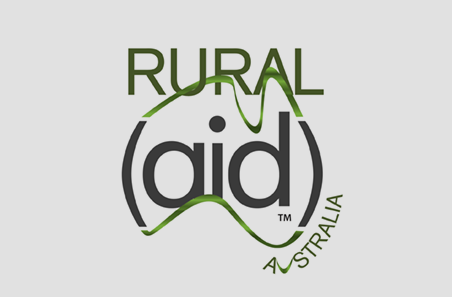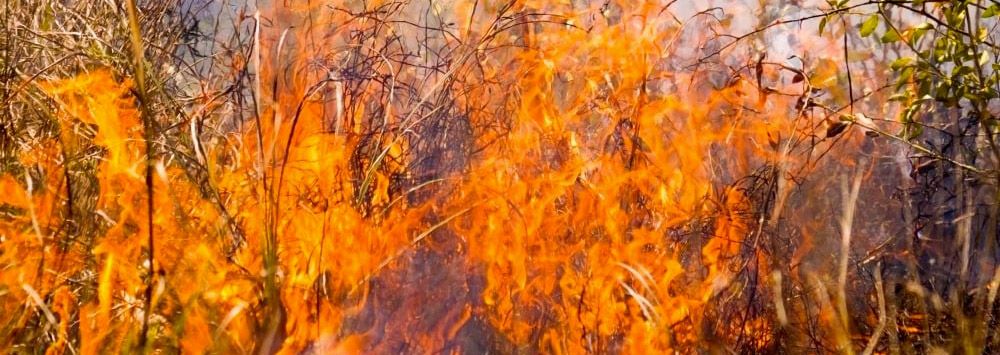
Prepare for bushfire season
Prepare for bushfire season
Meat & Livestock Australia (MLA) research has found that compared with producers who are unprepared, those who have a farm fire plan and appropriate equipment and training lose fewer livestock or suffer less infrastructure damage and can get back to business sooner after a fire.
Here you can find resources to help you prepare for bushfire season, learn what to do during a fire and resources to assist with bushfire recovery.
Year-round fire preparation and planning
Being prepared for fire is not something producers should do once a year or just at the start of summer. The best way to prepare for fire is to do a reasonable amount of work regularly, throughout the year, every year.
Your farm fire preparation plan should include:
- Prepare your property (e.g. reduce fuel, create an action plan).
- Discuss (leave or stay, action checklist as fire arrives, equipment).
- Know the conditions and bushfire alert levels.
- Keep up to date (fire authority apps and your own observations).
- Improve infrastructure to aid farm fire resilience.
- Ensure you have adequate insurance.
- Be self-sufficient (e.g. generator, food, medicines, communications, batteries).
- Plan emergency livestock management (e.g. refuge paddock, emergency veterinary assistance).
- Plan to recover after fire.
Read chapter two and three of the Bushfire preparation and recovery: A manual for livestock producers to learn more about how you can prepare for a bushfire.
What to do if a fire is approaching?
All fires are different. For some fires you may have several days’ warning – other fires may arrive suddenly with only minutes to prepare. Some fires will also hit on a very dangerous day, and all you can do is leave or shelter in your house. On other days, the fire may arrive when the weather is milder.
The warning you get, and the severity of the fire will affect what you have time to do and what it is safe to do.
Key tips if a fire is approaching
- Stay informed – know where there is fire.
- If the fire is days away put in firebreaks which is a strip of land that has been cleared of all combustible material (vegetation).
- Organise emergency feed for your livestock.
- Move stock to a refuge area and graze down.
Read chapter four of the Bushfire preparation and recovery: A manual for livestock producers to learn more about what to do if a fire is approaching.
The immediate aftermath of a bushfire, particularly in the first four weeks, is an important time for producers to assess damage to their property and livestock and, where possible, start to recover their businesses.
Read chapter five, six and seven of the Bushfire preparation and recovery: A manual for livestock producers for detailed information to help you recover from a bushfire.
Focusing on nutrition during recovery
Producers are advised to seek professional advice from a vet or animal nutritionist, particularly before feeding grain to livestock for the first time.

Cattle
This fact sheet provides best practice information for cattle producers for when they need to transition pasture-fed cattle to a diet of hay and/or grain in an emergency situation.
Download fact sheet

Weaners
This fact sheet provides best practice information in the immediate/short-term for when cattle producers need to feed calves and transition weaners to a diet of hay and grain pellets during an emergency.
Download fact sheet

Lambs and sheep
This fact sheet provides best practice information for lamb and sheep producers when they need to transition pasture-fed lambs and sheep to a diet of hay and grain in an emergency situation.
Download fact sheet
Bushfire resources
NSW Local Land Services provides a comprehensive information sheet on how to manage livestock after a fire.
Visit the NSW DPI Bushfire hub for information on bushfire preparation, recovery and assistance.
WA DPIRD provides information to support those suffering from the effects of fire on the farm.
Agriculture Victoria provides assistance to landholders and communities with animal welfare-related issues resulting from fires.
Safety of your animals is your responsibility. This fact sheet covers how to ensure the safety of your livestock in a fire emergency.
Guidelines from the Integrity Systems Company (ISC) to ensure your livestock are properly cared for and that the requirements of Australia’s red meat integrity system continue to be met in the event of a bushfire.
Your Guide to Farm Fire Safety from the Country Fire Authority Victoria is for people who are looking for practical tips and suggestions for managing farm fire risk. It covers everything from land and fuel management to equipment maintenance and the protection of livestock and crops from fire.
Your Guide to Farm Fire Safety is a useful resource for planning or promoting fire management on agricultural land day-to-day and year-round.
The WA Department of Fire & Emergency Services has prepared this bushfire recovery hub which includes resources and relevant information for WA residents affected by bushfire.
Agriculture Victoria has prepared this resource hub for Victorian producers affected by bushfire.
Visit this page on the Tasmanian Government website for resources and information about recovering from bushfire in Tasmania.
Bushfires NT provides fire management support in the fire protection zones across the Northern Territory (NT).
Read about:
Transport and agistment resources
While agistment can provide welcome relief following bushfire, offering feed or safety, all livestock movements, especially after a natural disaster pose an added biosecurity risk.



Fit to load
When transporting livestock, it’s essential that they are prepared and managed in a way that reduces stress and minimises risks to animal welfare. This hub includes information to help you decide if an animal is fit to be loaded for transport by road or rail.
Read more

Meeting LPA requirements for agistment
Agistment can provide welcome relief, offering safety to livestock. However livestock movements, especially after a natural disaster, pose an added biosecurity risk. This fact sheet provides information to help producers meet LPA requirements when agisting livestock.
Read more

Agisting livestock affected by bushfire
Often in the aftermath of fire, the most suitable alternative is to agist livestock away from affected properties. Agriculture Victoria provide key information for what southern producers need to consider when agisting livestock.
Read more
Getting back to business

Back to Business
The Back to Business webinars offer practical tips to help rebuild on the back of the recent bushfires, drought, floods and storms.
Watch webinars here

Back to Business podcasts
The Back to Business podcast series providing information to livestock producers as they get back to business following natural disasters.
Listen now
MLA eLearning toolbox

These eLearning packages provide the essential information you need as a livestock producer to prepare for and recover from bushfire, as well as handy quizzes to test your knowledge.
Module one: Bushfire preparationAt completion of this module, you will:
|
Module two: Bushfire recoveryAt completion of this module, you will:
|

Craig and Tamara Corby
After persevering through devastating bushfires, NSW beef producers Craig and Tamara Corby know a thing or two about the highs and lows of managing a livestock business. Find out more on their steps to recovery.
Read more

Troy and Nette Fischer
The Fischers’ resilience, goal setting and careful decision making, along with support from the community, ensured a return to productivity in under two years and paved the way for genetic gain after a fire engulfed their property.
Read more

Stuart Austin, Wilmot Cattle Co
The 2019–20 bushfire season was early, far-reaching and it hit hard for New England beef producer Stuart Austin. Four months on from the fire, Stuart had a chance to catch his breath and reflect on the experience.
Read more

Steve and Lucy Morgan
Sheep producers Steve and Lucy Morgan from Vivonne Bay on Kangaroo Island, SA share their top tips for preparing for and recovering from bushfires after participating in MLA's Back to Business program.
Read more
You will likely be exhausted, overwhelmed and stressed in the days after the fire. Help can come from governments, friends, family or neighbours. Here are some resources to assist you in seeking help.

Mental health support
If you, or someone you know, is struggling with mental health, you also can find a list of support services here.
Learn more

Lifeline
If you’re thinking about suicide or experiencing a personal crisis, get in touch with Lifeline. Call: 13 11 14
Learn more

Beyondblue
Offering phone, live chat, email and online forum services for anyone who just wants to talk. Call: 1300 22 4636
Learn more

Rural Aid
Critical support to farmers affected by natural disaster through financial, wellbeing and fodder assistance.
Learn more








